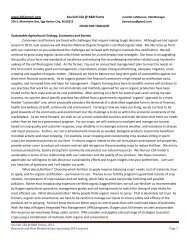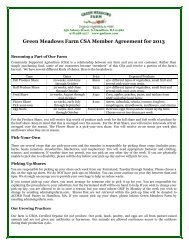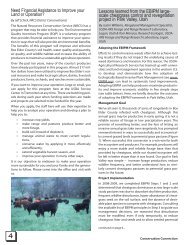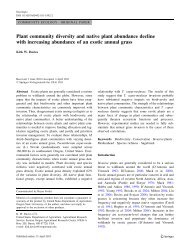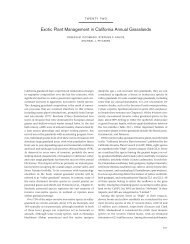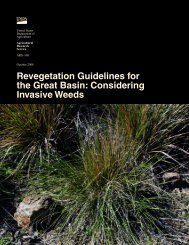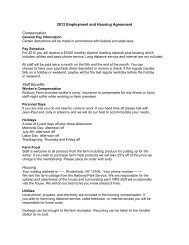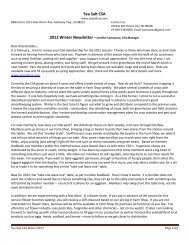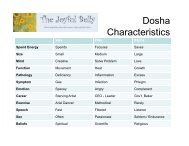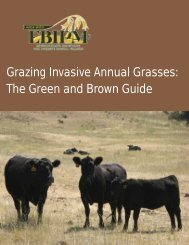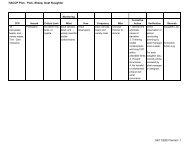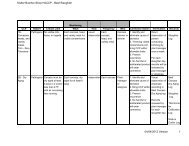Rangeland health attributes and indicators for qualitative assessment
Rangeland health attributes and indicators for qualitative assessment
Rangeland health attributes and indicators for qualitative assessment
You also want an ePaper? Increase the reach of your titles
YUMPU automatically turns print PDFs into web optimized ePapers that Google loves.
Approach used to develop the tech -<br />
nique. In 1995, the NRCS <strong>and</strong> BLM<br />
began development of <strong>qualitative</strong> techniques<br />
<strong>for</strong> the <strong>assessment</strong> of rangel<strong>and</strong><br />
<strong>health</strong> using the NRC (1994) <strong>and</strong> SRM<br />
Task Group (1995) recommendations as a<br />
starting point. These ef<strong>for</strong>ts resulted in the<br />
development of 2 similar protocols. The<br />
first 2 versions of this technique were<br />
developed separately by the BLM (Pellant<br />
1996) <strong>and</strong> NRCS (USDA, NRCS 1997).<br />
These versions were similar, but not identical.<br />
In 1997, we integrated these versions<br />
<strong>and</strong> began a coordinated ef<strong>for</strong>t to evaluate<br />
each indicator based on the scientific literature<br />
<strong>and</strong> field tests in rangel<strong>and</strong> ecosystems<br />
throughout the United States.<br />
Indicators that were not supported by the<br />
literature, that could not be consistently<br />
applied or interpreted, or that were not<br />
sensitive to changes in ecosystem structure<br />
or function across a wide variety of<br />
ecosystems, were modified, replaced or<br />
discarded. For example, repeatability<br />
among observers varied using the BLM<br />
version that contained only 3 rating categories<br />
(properly functioning, functioning<br />
at risk, <strong>and</strong> non-functioning) <strong>for</strong> 18 <strong>indicators</strong><br />
divided among a biotic <strong>and</strong> a physical<br />
attribute (Rasmussen et al. 1999). In<br />
response, we adjusted the rating categories<br />
to 5, the level used in the NRCS version of<br />
the technique.<br />
This iterative process involved approximately<br />
500 people participating in over 16<br />
training or testing sessions in 10 states<br />
covering 9 of the 36 ecosystem provinces<br />
of the humid, temperate <strong>and</strong> dry domains<br />
in the 48 contiguous states in the United<br />
States (Bailey et al. 1994). Participants<br />
included scientists (federal <strong>and</strong> university),<br />
federal, state, <strong>and</strong> tribal l<strong>and</strong> managers,<br />
ranchers <strong>and</strong> members of conservation<br />
organizations. Over 20 scientists, 25<br />
BLM <strong>and</strong> NRCS resource specialists, 35<br />
consultants from the Association of<br />
<strong>Rangel<strong>and</strong></strong> Consultants, <strong>and</strong> members of<br />
the Western Coordinating Committee on<br />
<strong>Rangel<strong>and</strong></strong> Ecological Research <strong>and</strong><br />
Assessment (WCC-40) reviewed <strong>and</strong> criticized<br />
the final draft of the technique. The<br />
technique <strong>and</strong> the document (Pellant et al.<br />
2000) were improved by incorporating<br />
modifications suggested by these peers.<br />
For example, training participants found it<br />
difficult to provide a single <strong>assessment</strong> of<br />
rangel<strong>and</strong> <strong>health</strong> <strong>for</strong> an evaluation area<br />
<strong>and</strong> that they wanted to be able to generate<br />
in<strong>for</strong>mation relevant to specific <strong>attributes</strong>.<br />
In response, we modified the technique to<br />
provide separate ratings <strong>for</strong> each of the 3<br />
<strong>attributes</strong> <strong>and</strong> to eliminate any reference to<br />
a single rating of overall status.<br />
Description of the Technique<br />
(Methods)<br />
Overview. The technique involves evaluating<br />
all locations using the same minimum<br />
set of 17 <strong>qualitative</strong> <strong>indicators</strong> relative<br />
to their potential within an ecological<br />
site. We use the Society <strong>for</strong> Range<br />
Management (SRM Glossary Update Task<br />
Group 1998) definition of an ecological<br />
site being “a kind of l<strong>and</strong> with specific<br />
physical characteristics which differs from<br />
other kinds of l<strong>and</strong> in its ability to produce<br />
distinctive kinds <strong>and</strong> amounts of vegetation<br />
<strong>and</strong> in its response to management.”<br />
Site potential <strong>for</strong> each indicator is defined<br />
by that indicator’s presence <strong>and</strong> range of<br />
amount in resistant <strong>and</strong> resilient plant<br />
community phases that maximize retention<br />
of soil. These may be determined by<br />
examining a range of reference areas that<br />
describe these phases or they may be<br />
defined in or inferred from the ecological<br />
site description. Ecological site descriptions<br />
describe soil associations (as defined<br />
by the Soil Science Society of America<br />
1997) <strong>and</strong> their physical, hydrological <strong>and</strong><br />
biological characteristics that produce distinctive<br />
kinds <strong>and</strong> amounts of vegetation.<br />
The amount of in<strong>for</strong>mation included in<br />
ecological site descriptions varies depending<br />
on when the description was written.<br />
Early descriptions, originally called range<br />
site descriptions, contained basic descriptions<br />
of soils <strong>and</strong> vegetation. Ecological<br />
site descriptions written or revised since<br />
1997 contain additional detail on the variation<br />
in plant composition, cover <strong>and</strong> production<br />
<strong>for</strong> the dynamic set of vegetation<br />
states <strong>and</strong> on hydrologic <strong>and</strong> soil stability<br />
characteristics of the ecological site. The<br />
NRCS has committed to a program of<br />
revising all previously written range site<br />
<strong>and</strong> ecological site descriptions into this<br />
new <strong>for</strong>mat (Pers. Comm. G. Peacock,<br />
NRCS Grazing L<strong>and</strong>s Technology<br />
Institute, Fort Worth Tex.). All currently<br />
approved ecological site descriptions are<br />
available at local NRCS offices. In addition,<br />
they will be available on the Internet<br />
at the PLANTS database homepage<br />
(USDA, NRCS 2001) under the<br />
Ecological Site In<strong>for</strong>mation System<br />
(ESIS) heading. If neither reference areas<br />
nor an ecological site description exist,<br />
then a group of soil <strong>and</strong> plant experts<br />
should define <strong>and</strong> document their expectations<br />
<strong>for</strong> each of these <strong>indicators</strong> using<br />
their knowledge <strong>and</strong> data about similar<br />
soils <strong>and</strong> plant communities.<br />
Three overlapping subsets of <strong>indicators</strong><br />
are used to assess 3 <strong>attributes</strong> of the site:<br />
soil <strong>and</strong> site stability, hydrologic function,<br />
<strong>and</strong> biotic integrity. We use the term<br />
attribute to describe an ecosystem component<br />
that cannot be directly measured, but<br />
can be approximated by a set of observable<br />
<strong>indicators</strong> of the component. The<br />
<strong>assessment</strong> of these 3 <strong>attributes</strong> is the final<br />
product of the technique. In the remainder<br />
of this section, we describe <strong>attributes</strong> <strong>and</strong><br />
<strong>indicators</strong>, outline the technique that is<br />
used to evaluate each indicator relative to<br />
its potential <strong>for</strong> a particular site. We<br />
include a new method <strong>for</strong> documenting<br />
reference conditions <strong>for</strong> each indicator <strong>and</strong><br />
define how the 3 <strong>attributes</strong> are evaluated<br />
based on a combination of <strong>indicators</strong> to<br />
arrive at an <strong>assessment</strong> of the status of<br />
each attribute.<br />
Attributes. Both the SRM Task Group<br />
(1995) <strong>and</strong> the NRC (1994) reports suggested<br />
a single rating <strong>for</strong> the site <strong>assessment</strong>.<br />
The SRM Task Group (1995)<br />
emphasized soil conservation in their<br />
hypothetical quantitative approach. They<br />
proposed the development of a Site<br />
Conservation Rating (SCR), “an <strong>assessment</strong><br />
of the protection af<strong>for</strong>ded a site by<br />
the current vegetation against loss of<br />
potential.” They also proposed that a Site<br />
Conservation Threshold (SCT), “the kind,<br />
amount, <strong>and</strong>/or pattern of vegetation needed<br />
as a minimum on a given site to prevent<br />
accelerated erosion,” would provide a<br />
mechanism <strong>for</strong> categorizing a site as “satisfactory<br />
or sustainable” or “unsatisfactory<br />
or unsustainable.” Although this Task<br />
Group proposed this new approach <strong>for</strong><br />
evaluating l<strong>and</strong>s, they clearly stated that<br />
criteria <strong>for</strong> evaluating the SCR <strong>and</strong> SCT<br />
should be objective <strong>and</strong> quantitative<br />
enough to serve as monitoring parameters<br />
<strong>for</strong> assessing the trend in the SCR.<br />
However, these criteria “will have to be<br />
worked out by research <strong>and</strong> professional<br />
judgment <strong>for</strong> each ecological site” (SRM<br />
Task Group 1995). To our knowledge, few<br />
studies have attempted to develop or test<br />
quantitative criteria <strong>for</strong> a SCR (Watters et<br />
al. 1996) whereas some development has<br />
begun <strong>for</strong> some <strong>indicators</strong> of <strong>for</strong>est <strong>and</strong><br />
rangel<strong>and</strong> <strong>health</strong> or sustainability (de<br />
Soyza et al. 1997, 2000, Weltz et al. 2000,<br />
Woodley et al. 2000, Herrick et al. 2002).<br />
The NRC (1994) suggested classifying<br />
l<strong>and</strong>s into 3 categories using soil <strong>and</strong> ecological<br />
processes as basic elements of site<br />
production: (1) those l<strong>and</strong>s that remain<br />
above an early warning line where the<br />
l<strong>and</strong> produces at its potential <strong>for</strong> commodities<br />
<strong>and</strong> other values; (2) those that<br />
fall below this early warning line <strong>and</strong> have<br />
a reduced ability to produce commodities<br />
<strong>and</strong> support other values, but where this<br />
reduction can be reversed through man-<br />
586 JOURNAL OF RANGE MANAGEMENT 55(6) November 2002



